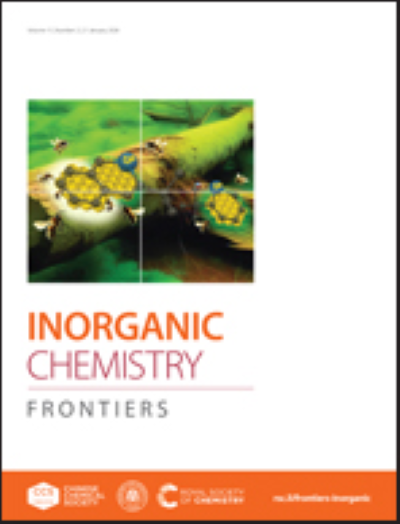钴磷-三氮种的不同脱氮和硝基转移途径
IF 6.1
1区 化学
Q1 CHEMISTRY, INORGANIC & NUCLEAR
引用次数: 0
摘要
金属-亚硝基是氮官能团结合的关键中间体,对相应的有机叠氮化物加合物形成金属-亚硝基的机制有更好的了解是非常必要的。在这项工作中,我们展示了一种在含磷化物(PPP)Co支架上进行有机叠氮脱氮的新模式。二聚体钴与有机叠氮化合物通过选择性[2+3]环加成反应生成相应的钴(II)磷杂化配合物。这种金属-配体协同(MLC)转化涉及P-P键的裂解以及Co-N - rnd和p - n - γ键的形成,表明co -磷化物位点作为有机叠氮结合的锚定位点。还原后的Co(I)磷基配合物与亲电试剂如B(C6F5)3和甲基化试剂在n - γ位置反应生成硼烷加合物和甲基。这种锚定的有机叠氮化物基团的亲电功能化导致了离域叠氮化物基团的显著减少和Nβ-Nγ距离的延长,使其易于热解的Nβ-Nγ键断裂。所得到的亚硝基烯片段与磷化物片段或外源腈发生反应,形成相应的亚磷酸酯或氨基磷化物。这种反应性提供了一种新的有机叠氮化物活化模式,不同于以往主要以N𝛼-Nβ键裂解为特征的研究。本文章由计算机程序翻译,如有差异,请以英文原文为准。
Divergent Deazotation and Nitrene Group Transfer Pathways at Cobalt Phospha-Triazene Species
Metal-nitrenes are critical intermediates in the incorporation of nitrogen functional groups, and a better understanding of the mechanism of their formation from the corresponding organoazide adducts is highly desirable. In this work, we demonstrate a new mode of organoazide deazotation at a phosphide-containing (PPP)Co scaffold. A dimeric cobalt species reacts with organoazides to furnish the corresponding cobalt(II) phosphazido complexes via selective [2+3] cycloaddition. This metal-ligand cooperative (MLC) transformation involves P–P bond cleavage along with Co–N𝛼 and P–Nγ bond formation, revealing that the Co-phosphide site acts as an anchoring site for organoazide binding. The reduced Co(I) phosphazido complexes react with electrophiles such as B(C6F5)3 and methylating reagents at the Nγ position to give the respective borane adduct and methyl species. The electrophilic functionalization of such anchored organoazide moieties leads to a significantly less delocalized azide moiety and elongation of the Nβ–Nγ distance, rendering it susceptible toward thermolytic Nβ–Nγ bond cleavage. The resulting nitrene moiety reacts with the phosphide moiety or with exogenous nitriles to form the respective iminophosphide or phospha-amidinate species. Such reactivity provides a new mode of organoazide activation distinct from previous studies that primarily feature N𝛼–Nβ bond cleavage.
求助全文
通过发布文献求助,成功后即可免费获取论文全文。
去求助
来源期刊

Inorganic Chemistry Frontiers
CHEMISTRY, INORGANIC & NUCLEAR-
CiteScore
10.40
自引率
7.10%
发文量
587
审稿时长
1.2 months
期刊介绍:
The international, high quality journal for interdisciplinary research between inorganic chemistry and related subjects
 求助内容:
求助内容: 应助结果提醒方式:
应助结果提醒方式:


